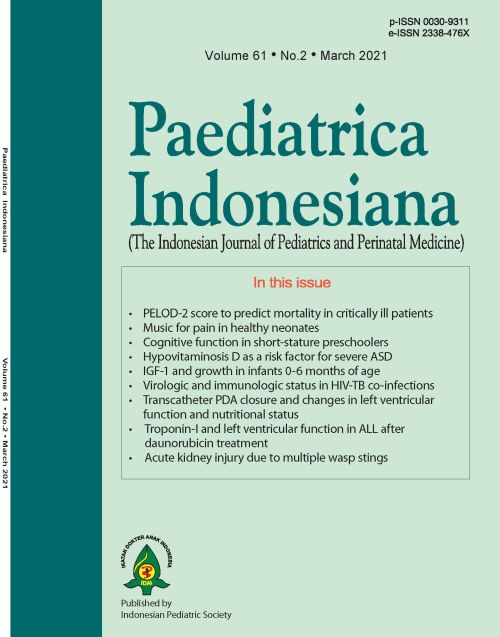Modifying the PELOD-2 score to predict mortality in critically ill patients
Abstract
Background The PELOD-2 score, which has been widely used to predict multiple organ dysfunction, may be used to predict mortality. Nevertheless, blood gas analyses (BGA) and lactate measurements required for the PELOD-2 cannot be performed in most limited resource settings.
Objective To evaluate the performance of modified PELOD-2, without BGA and lactate, to predict mortality in critically ill children.
Methods This retrospective cohort study in critically ill children admitted to the pediatric intensive care unit (PICU), Dr. Sardjito Hospital, Yogyakarta, was undertaken from January to December 2018. The modifications to the PELOD-2 score were PELOD-2A (without BGA), PELOD-2B (without lactate), and PELOD-2C (without BGA and lactate). The modified PELOD-2 scores were evaluated using receiver operating characteristic (ROC) curve for discrimination, and Hosmer-Lemeshow goodness-of-fit test for calibration.
Results Of 130 subjects, 68 (52.3%) died. A PELOD-2 score cut-off of 6.5 and modified PELOD-2A, 2B, and 2C had sensitivities for predicting mortality of 73.5%, 67.7%, 70.6%, and 63.2%, respectively, and specificities of 75.8%, 77.4%, 77.4%, and 79%, respectively. The area under curve (AUC) of the PELOD-2 score was 78.3 (95%CI 70.5 to 86.2). The AUCs of the modified PELOD-2 scores ranged from 76.8 (95%CI 68.7 to 84.9) to 77.9 (95% CI 69.9 to 85.8). The positive predictive values of PELOD-2 and modified PELOD-2A, 2B, 2C were 76.9%, 76.7%, 77.4% and 76.8%, respectively. The Hosmer-Lemeshow goodness-of-fit test showed good calibration for PELOD-2 (x2=8.74; P=0.27) and modified PELOD-2A (x2=4.91; P=0.67).
Conclusion The PELOD-2A, modified without BGA, can still predict mortality well in critically ill PICU patients when using a cut-off score ≥ 6.5.
References
2. Siddiqui NUR, Ashraf Z, Jurair H, Haque A. Mortality patterns among critically ill children in a Pediatric Intensive Care Unit of a developing country. Indian J Crit Care Med. 2015;19:147–50. DOI: 10.4103/0972-5229.152756
3. Alsuheel AM, Shati AA. Factors predicting mortality in pediatric intensive care unit in a tertiary care center southwest region, Saudi Arabia. J Med Med Sci. 2014;5:113–20. DOI: 10.14303/jmms.2014.085
4. El-Nawawy A, Mohsen AA, Abdel-Malik M, Taman SO. Performance of the pediatric logistic organ dysfunction (PELOD) and (PELOD-2) scores in a pediatric intensive care unit of a developing country. Eur J Pediatr. 2017;176:849–55. DOI: 10.1007/s00431-017-2916-x
5. Wulandari A, Martuti S, Kaswadi P. Perkembangan diagnosis sepsis pada anak. Sari Pediatr. 2017;19:237–44. DOI: 10.14238/sp19.4.2017.237-44
6. Leteurtre S, Duhamel A, Deken V, Lacroix J, Leclerc F. Daily estimation of the severity of organ dysfunctions in critically ill children by using the PELOD-2 score. Crit Care. 2015;19:324–30. DOI: 10.1186/s13054-015-1054-y
7. Suari NMR, Latief A, Pudjiadi AH. Validitas skor PELOD 2 pada anak dengan sepsis di RSUPN Cipto Mangunkusumo. Proceeding of The 10th PICU NICU Updates - Comprehensive Management in Perioperative Newborn Infants & Children, in conjunction with Integrated Respiratory Support Summit in Critically Ill Newborn Infants & Childrens; 2018 March 20-26; Bali, Indonesia. p. 42 .
8. Pollack MM, Holubkov R, Funai T, Dean JM, Berger JT, Wessel DL, et al. The pediatric risk of mortality score: update 2015. Pediatr Crit Care Med. 2016;17:2–9. DOI: 10.1097/PCC.0000000000000558
9. Honna L, Triratna S, Triwani, Theodorus. Use of pediatric logistic organ dysfunction (PELOD) in determining prognostic among pediatric intensive care unit patients. Paediatr Indones. 2010;50:347–50. DOI: 10.14238/pi
10. Susianawati V, Suryantoro P, Naning R. Prognostic predictor at pediatrics intensive care unit ( PICU ) with pediatric risk of mortality III ( PRISM III ) scores. J Med Sci. 2014;46:71–7. DOI: 10.19106/JMedScie004602201403
11. Sari DSP, Saputra I, Triratna S, Saleh MI. The pediatric index of mortality 3 score to predict mortality in a pediatric intensive care unit in Palembang, South Sumatera, Indonesia. Pediatr Indones. 2017;57:164–70. DOI: 10.14238/pi57.3.2017.164-70
12. El Hamshary AAE, El Sherbini SA, Elgebaly HAF, Amin SA. Prevalence of multiple organ dysfunction in the pediatric intensive care unit: Pediatric Risk of Mortality III versus Pediatric Logistic Organ Dysfunction scores for mortality prediction. Rev Bras Ter Intensiva. 2017;29:206–12. DOI: 10.5935/0103-507X.20170029
13. Qureshi AU, Ali AS, Ahmad TM. Comparison of three prognostic scores (PRISM, PELOD and PIM 2) at pediatric intensive care unit under Pakistani circumstances. J Ayub Med Coll Abbottabad. 2007;19:49–53. PMID: 18183720
14. Leteurtre S, Duhamel A, Salleron J, Grandbastien B, Lacroix J, Leclerc F. Pelod-2 An Update of the pediatric logistic organ dysfunction score. Crit Care Med. 2013;41:1761–73. DOI: 10.1186/s13054-015-1054-y
15. Dewi R, Fatimatuzzuhroh F. Profil Pasien sakit kritis yang dirawat di pediatric intensive care unit Rumah Sakit Cipto Mangunkusumo berdasar sistem skoring Pediatric Logistic Organ Dysfunction-2. Sari Pediatr. 2019;21:37. DOI: 10.14238/sp21.1.2019.37-43
16. Bai Z, Zhu X, Li M, Hua J, Li Y, Pan J. Effectiveness of predicting in-hospital mortality in critically ill children by assessing blood lactate levels at admission. BMC Pediatr. 2014;14:1–9. DOI: 10.1186/1471-2431-14-83
17. Nichol AD, Egi M, Pettila V, Bellomo R, French C, Hart G, et al. Relative hyperlactatemia and hospital mortality in critically ill patients: a retrospective multi-centre study. Crit Care. 2010;14:R25. DOI: 10.1186/cc8888
18. Patriawati KA, Nurnaningsih N, Suryantoro P. Serial blood lactate levels as a prognostic factor for sepsis mortality. Pediatr Indones. 2014;54:168–73. DOI: 10.14238/pi
19. Gonçalves JP, Severo M, Rocha C, Jardim J, Mota T, Ribeiro A. Performance of PRISM III and PELOD-2 scores in a pediatric intensive care unit. Eur J Pediatr. 2015;174:1305-10. DOI: 10.1007/s00431-015-2533-5
Copyright (c) 2021 Melda Melda

This work is licensed under a Creative Commons Attribution-NonCommercial-ShareAlike 4.0 International License.
Authors who publish with this journal agree to the following terms:
Authors retain copyright and grant the journal right of first publication with the work simultaneously licensed under a Creative Commons Attribution License that allows others to share the work with an acknowledgement of the work's authorship and initial publication in this journal.
Authors are able to enter into separate, additional contractual arrangements for the non-exclusive distribution of the journal's published version of the work (e.g., post it to an institutional repository or publish it in a book), with an acknowledgement of its initial publication in this journal.
Accepted 2021-02-05
Published 2021-02-05













